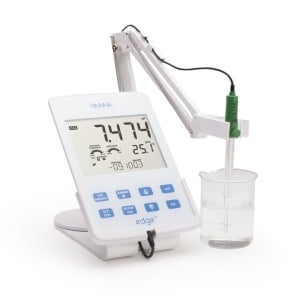
With over 2.5 billion cups consumed daily, coffee is one of the most popular drinks in the world. Globally, the coffee industry earns $60 billion dollars per year and is the most sought after commodity after crude oil. In the last 25 years, there has been a movement toward the appreciation and manufacturing of high-quality coffee. This movement, known as the “third wave of coffee,” affects all aspects of coffee making including bean growing, harvesting, and brewing. In turn, modern-day baristas are making efforts to increase recognition of specialty coffees and raise awareness of the science behind a quality brew.
The process of brewing quality coffee is deceptively simple; numerous factors affect the final brew including roast freshness, grind freshness, and water quality. Water quality is especially important because it facilitates the extraction of soluble components from the coffee grounds into the water; each of the 600 volatile compounds present in coffee beans is uniquely affected by the brewing water’s composition. Properties such as pH, alkalinity, hardness, and total dissolved solids all impact the final product.
The amount of total dissolved solids (TDS) present in brewing water directly correlates with its extraction efficiency. The high mineral content of brewing water also contributes an unwanted taste. Organizations such as the Specialty Coffee Association of America suggest a TDS level of 150 mg/L for brewing water. Examples of dissolved solids in brewing water include calcium, magnesium, and chlorides. When the TDS of brewing water is below 75 mg/L, the coffee is easily over-extracted. When the TDS is above 250 mg/L, the coffee is under-extracted due to sufficient absorption of the soluble coffee solids.
In addition to the importance of TDS in brewing water, the TDS value of the final brewed coffee can be used to indicate the strength of the brew. Strong coffee has higher values of TDS, while weaker coffee will have lower TDS values. Americans typically prefer coffee with a TDS measurement of 1.2—1.5% (12—15 g/L), while Europeans typically prefer their coffee slightly stronger. It is important to note TDS measurements are inferred from conductivity measurements; many components of coffee are non-conductive and therefore, not accounted for. Regardless, some hobbyists still use these relative TDS readings to track and quantify changes in brew strength.
Most recently, smartphone applications have been designed for coffee testing, making it easy for baristas and coffee professionals to determine the characteristics of their final brew. The TDS of their brew is input into the app as well as the mass of coffee, and the volume of water. The app uses this information to automatically calculate parameters such as extraction yield and brew ratio. Extraction yield indicates the amount of coffee extracted from the beans, while brew ratio relates the mass of coffee used to the volume of water used.

A specialty coffee shop contacted Hanna Instruments looking to test the effectiveness of an in-line water filter designed for use with their coffee makers. By measuring the TDS of brewing water before and after filtration, the shop confirmed the proper operation of their filtration system.
The customer also wanted the ability to measure the TDS of their brewed coffee. As a result, the customer verified the strength of their coffee across multiple brewing sessions. The customer had limited benchtop space and wanted an easy-to-use meter with a small footprint and high accuracy. Hanna offered the edge® Dedicated Conductivity/TDS/Salinity Meter - HI2003 kit with the included HI763100 - Digital EC/Temperature Electrode, a four-ring conductivity probe.
The wide measurement range from 0.00 mg/L—499 g/L allowed the customer to measure both the TDS of their water and brewed coffee on the same meter. The customer valued the versatility of edge® as a portable or benchtop meter, as well the option for placing it in the wall mount cradle. The wall-mount cradle not only conserves space in the work area, but features an AC adapter to charge edge® while mounted. The “Basic Mode” feature allowed them to swiftly operate the meter with minimal technical training required of their staff. Easy logging and transfer of readings via USB made data management simple, allowing them to monitor TDS values over time. In turn, the coffee shop was able to monitor lifespan of their water filters as well as ensure a consistent coffee strength from brew to brew.
As a leader in innovation Hanna Instruments developed the HALO Wireless pH Meter, which uses Bluetooth Smart Technology to connect to Apple and Android devices running the Hanna Lab App.
Continuing with this tradition, the Hanna Instruments Blog is devoted to sharing the latest in product overviews, how-to guides, and industry specific news to our ever-growing audience.
Contact us at sales@hannainst.com.
